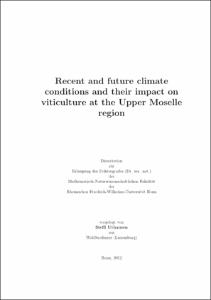Urhausen, Steffi: Recent and future climate conditions and their impact on viticulture at the Upper Moselle region. - Bonn, 2013. - Dissertation, Rheinische Friedrich-Wilhelms-Universität Bonn.
Online-Ausgabe in bonndoc: https://nbn-resolving.org/urn:nbn:de:hbz:5n-32993
Online-Ausgabe in bonndoc: https://nbn-resolving.org/urn:nbn:de:hbz:5n-32993
@phdthesis{handle:20.500.11811/5729,
urn: https://nbn-resolving.org/urn:nbn:de:hbz:5n-32993,
author = {{Steffi Urhausen}},
title = {Recent and future climate conditions and their impact on viticulture at the Upper Moselle region},
school = {Rheinische Friedrich-Wilhelms-Universität Bonn},
year = 2013,
month = aug,
note = {Climate plays a decisive role in viticulture. It has a large impact on the duration of the vegetative cycle, on the health of the vines and on the quality of the harvest. Under a changing climate wine characteristics may change and some vine varieties could become unproductive. The goal of this study is to develop statistical models for phenological event dates (budburst and flowering) and must quality (must density and acidity) for the Upper Moselle region, especially for the Luxembourgian viticulture. First, the regional climate and the phenological states of different vine varieties during the time period 19512005 are analysed. Significant trends are detected in annual, spring and summer temperatures. Vine phenology is also found to have changed significantly: budburst date and flowering events occur earlier by about two weeks, must density has increased and acidity decreased. The derived models are based on a linear multiple regression method using forward and backward steps. The predictors tested are mainly temperature means for different time periods or temperature derived indices. In addition, precipitation and sunshine duration for different time periods are evaluated. The most important predictors for budburst and flowering dates are temperature based variables. Depending on the vine variety and the phenological event, the model explains 80-89% of the variance. Besides temperature, sunshine duration and precipitation become important for must density and acidity estimations. The models reproduce must density with an explained variance between 59% and 79%, and acidity with 62%-88% explained variance depending on vine variety. The regional climate model COSMO-CLM (CCLM) is used to estimate future climate conditions under different scenarios and the future evolution of phenology and must quality. The realisations of CCLM during 1960-2000 differ significantly from the observations and thus a calibration of the model output was needed. The results show a large variability of the climate model output and clear estimations for future phenological event dates and must quality are difficult. Assuming the A1B scenario, budburst and flowering dates are likely to become earlier. Must density has significant increasing and acidity decreasing trends. The B1 scenario shows more moderate results: budburst date may move backward but flowering dates seem to not change significantly. Large changes in must density and acidity are not expected.},
url = {https://hdl.handle.net/20.500.11811/5729}
}
urn: https://nbn-resolving.org/urn:nbn:de:hbz:5n-32993,
author = {{Steffi Urhausen}},
title = {Recent and future climate conditions and their impact on viticulture at the Upper Moselle region},
school = {Rheinische Friedrich-Wilhelms-Universität Bonn},
year = 2013,
month = aug,
note = {Climate plays a decisive role in viticulture. It has a large impact on the duration of the vegetative cycle, on the health of the vines and on the quality of the harvest. Under a changing climate wine characteristics may change and some vine varieties could become unproductive. The goal of this study is to develop statistical models for phenological event dates (budburst and flowering) and must quality (must density and acidity) for the Upper Moselle region, especially for the Luxembourgian viticulture. First, the regional climate and the phenological states of different vine varieties during the time period 19512005 are analysed. Significant trends are detected in annual, spring and summer temperatures. Vine phenology is also found to have changed significantly: budburst date and flowering events occur earlier by about two weeks, must density has increased and acidity decreased. The derived models are based on a linear multiple regression method using forward and backward steps. The predictors tested are mainly temperature means for different time periods or temperature derived indices. In addition, precipitation and sunshine duration for different time periods are evaluated. The most important predictors for budburst and flowering dates are temperature based variables. Depending on the vine variety and the phenological event, the model explains 80-89% of the variance. Besides temperature, sunshine duration and precipitation become important for must density and acidity estimations. The models reproduce must density with an explained variance between 59% and 79%, and acidity with 62%-88% explained variance depending on vine variety. The regional climate model COSMO-CLM (CCLM) is used to estimate future climate conditions under different scenarios and the future evolution of phenology and must quality. The realisations of CCLM during 1960-2000 differ significantly from the observations and thus a calibration of the model output was needed. The results show a large variability of the climate model output and clear estimations for future phenological event dates and must quality are difficult. Assuming the A1B scenario, budburst and flowering dates are likely to become earlier. Must density has significant increasing and acidity decreasing trends. The B1 scenario shows more moderate results: budburst date may move backward but flowering dates seem to not change significantly. Large changes in must density and acidity are not expected.},
url = {https://hdl.handle.net/20.500.11811/5729}
}






